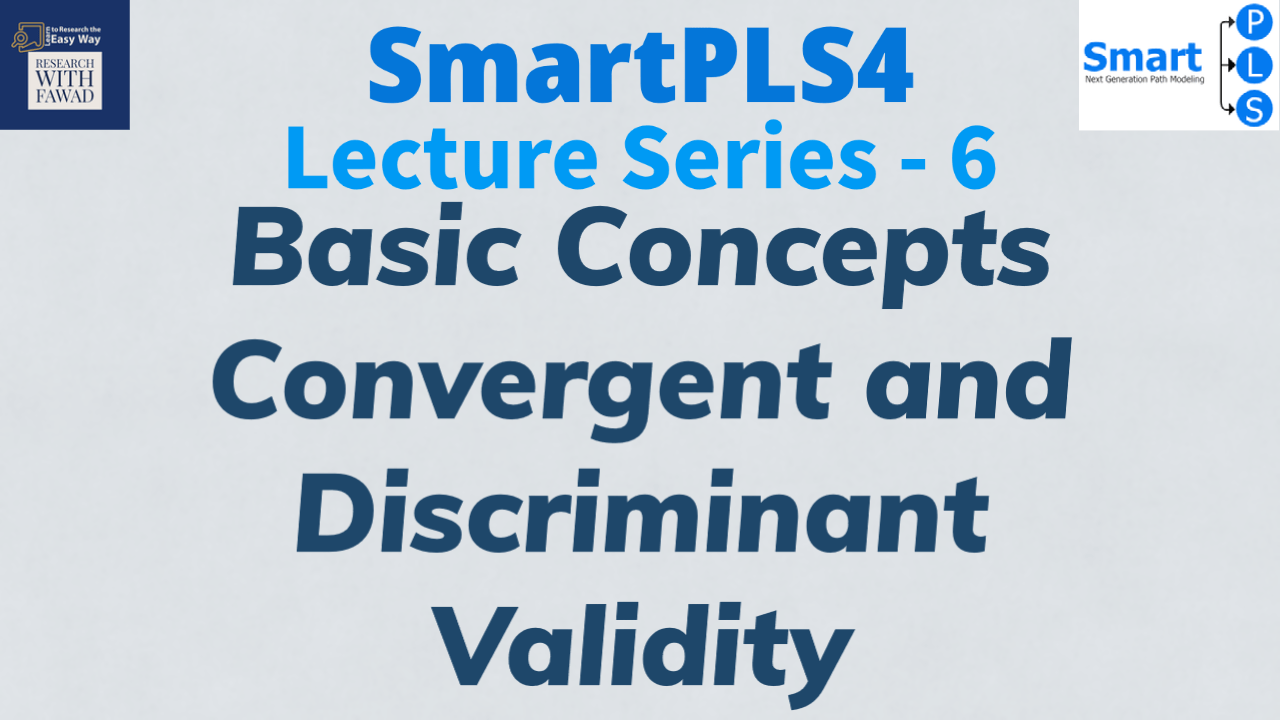Basic Concepts in SEM: Convergent and Discriminant Validity

Basic SEM Concepts: Convergent and Discriminant Validity
For Complete Step by Step SmartPLS4 Tutorial Playlist, Click Here
Concept of Construct Validity
In Structural Equation Modelling, a model is based on assessment of Measurement and Structural Model. First, measurement measurement models are assessed on the grounds of indicator reliability, internal consistency reliability, convergent validity, and discriminant validity.
Finally, Structural Model are assessed to substantiate the proposed hypotheses. In this section, i briefly discuss the concept of convergent and discriminant validity. In the preceding session, we delved into fundamental concepts such as factor loading, beta coefficient, and reliability. These concepts form integral components of the measurement model assessment, a subject we will continue exploring in this session and subsequent ones. To gain a more comprehensive understanding of measurement model assessment, a helpful resource distinguishes between measurement model assessment and structural model assessment, elucidating their connections to structural equation modeling.
Validating a measurement tool revolves around the concept of accuracy. The term that encapsulates this idea is “validity,” questioning the precision with which items or constructs are measured. The crucial inquiry is whether the construct is measuring precisely what it intends to measure. To address this statistically, one must establish statistical validity, specifically construct validity. Content validity and face validity, accomplished through existing research or expert opinions, contribute to construct validity.
What is Convergent Validity?
Construct validity assumes two forms, the first being convergent validity. This validity is substantiated through average variance extracted (AVE), representing the extent of variance extracted by the latent construct from its indicators. For convergent validity to be established, the items must converge or come together, collectively representing the latent construct. AVE surpassing 0.50 is indicative of successful convergent validity. Future discussions will elaborate on calculating and reporting AVE, emphasizing its role in affirming construct validity. The AVE is defined as the grand mean value of the squared loadings of the indicators associated with the construct (i.e., the sum of the squared loadings divided by the number of indicators). Therefore, the AVE is equivalent to the communality of a construct.
What is Discriminant Validity?
The second facet of construct validity is discriminant validity, essential when dealing with multiple constructs. Discriminant validity measures the extent to which a construct is empirically distinct from other constructs. The most common metrics used to establish discriminant validity include Fornell & Larcker (1981) criterion and Heterotrait-Monotrait Ratio. Discriminant validity ensures the distinctiveness of each construct, affirming their individual identity. To establish this differentiation, three methods are employed: Fornell-Larcker criterion, Heterotrait-Monotrait ratio, and Cross loadings. Smart PLS automates the calculation of these methods, alleviating the need for manual computation.
In the upcoming session, we will delve into the practical application of Smart PLS to establish convergent validity. This discussion will shed light on how Smart PLS facilitates the calculation of AVE, a pivotal step in affirming the convergence of items to represent the underlying construct.
Reference
License (http://creativecommons.org/licenses/by/4.0/)
Video
Additional SmartPLS 4 Tutorials
- A Basic and Simple Model in SmartPLS4
- Basic Structural Equation Modelling (SEM) Concepts
- Categorical Moderation Analysis using SEMinR
- How to Assess Construct Reliability?
- How to Assess Convergent Validity (Construct validity)
- How to Assess Discriminant Validity (Construct validity)
- How to Assess Reflective-Reflective Higher Order Construct
- How to Design a Measurement Model?
- How to Enter Data in SPSS or Excel
- How to Solve Discriminant Validity Issues
- How to Use Necessary Condition Analysis in SmartPLS4?
- Reflective-Formative Higher-Order Model using SmartPLS4
- Simple Structural Model in SmartPLS4
- SmartPLS4 Tutorials Series Introduction
- Steps in Data Analysis
- What is a Formative Construct?